Abstract
OBJECTIVE: To investigate the fetal angiotensin II type 1 receptor genotype in pre-eclampsia. DESIGN: Case-control study. POPULATION: Forty-one maternal-fetal pairs from pre-eclamptic pregnancies and 80 maternal-fetal pairs from normotensive pregnancies. METHODS: Maternal and fetal DNA was genotyped at three diallelic polymorphisms, at nucleotides 573, 1062, and 1166, in the coding exon of the angiotensin II type 1 receptor gene, and at a dinucleotide repeat polymorphism in its 3' flanking region. RESULTS: Allele and genotype frequencies at the four polymorphic regions investigated did not differ between pre-eclamptic and normotensive groups, in either fetal or maternal samples. Mothers heterozygous for the dinucleotide repeat allele designated A4 transmitted this allele to the fetus in 15 of 18 informative pre-eclamptic pregnancies and in eight of 26 normotensive pregnancies. This was greater than the expected probability in pre-eclamptic pregnancies (p=0.04) and less than expected in normotensive pregnancies (p<0.005). The 573T variant, which is in partial linkage disequilibrium with the A4 allele, showed a similar distortion of maternal-fetal transmission. CONCLUSION: Angiotensin II type 1 receptor gene expression in the fetus may contribute to the aetiology of pre-eclampsia. It is unclear whether susceptibility is conferred by the fetal genotype acting alone, or by allele sharing by mother and fetus. Possible mechanisms for the effect of the angiotensin II type 1 receptor gene are suggested by the association of the 573T variant with low levels of surface receptor expression on platelets. If receptor expression is similarly genetically determined in the placenta, responsiveness to angiotensin II may be affected, with the potential to influence placentation or placental prostaglandin secretion.
Full text
PDF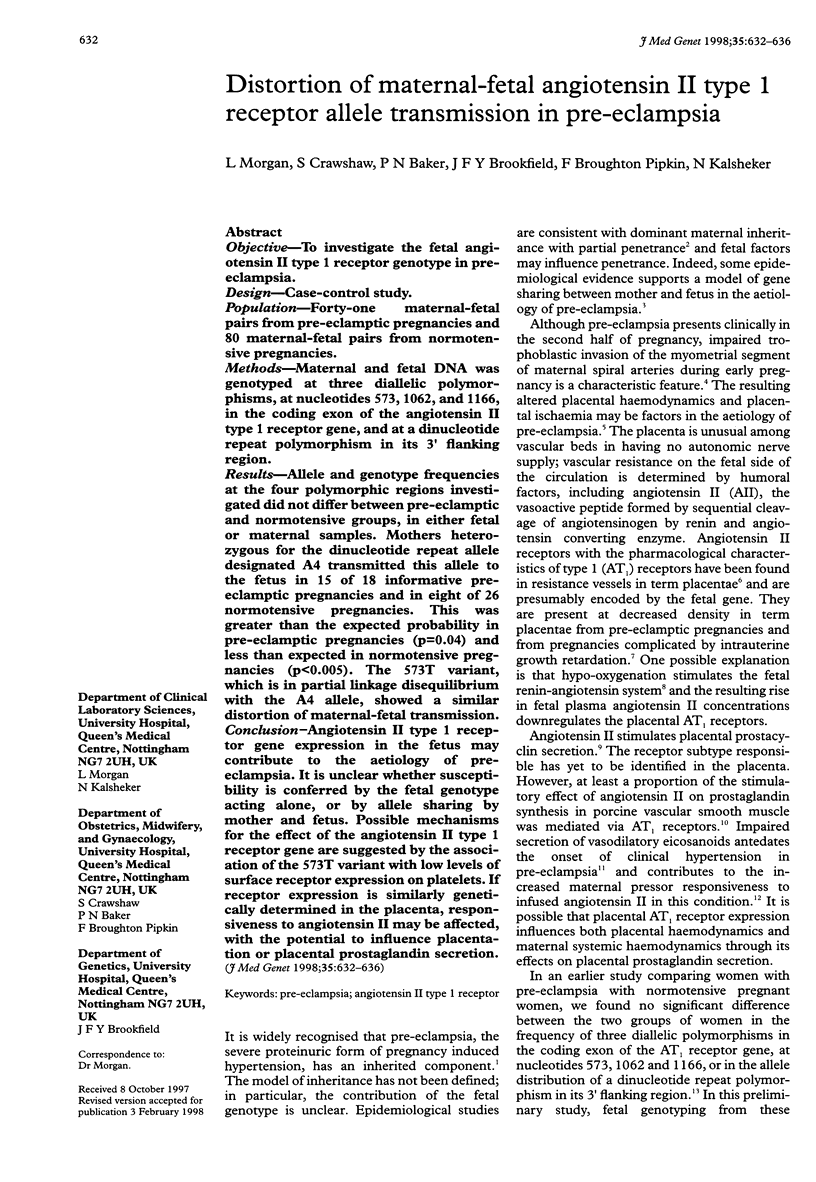
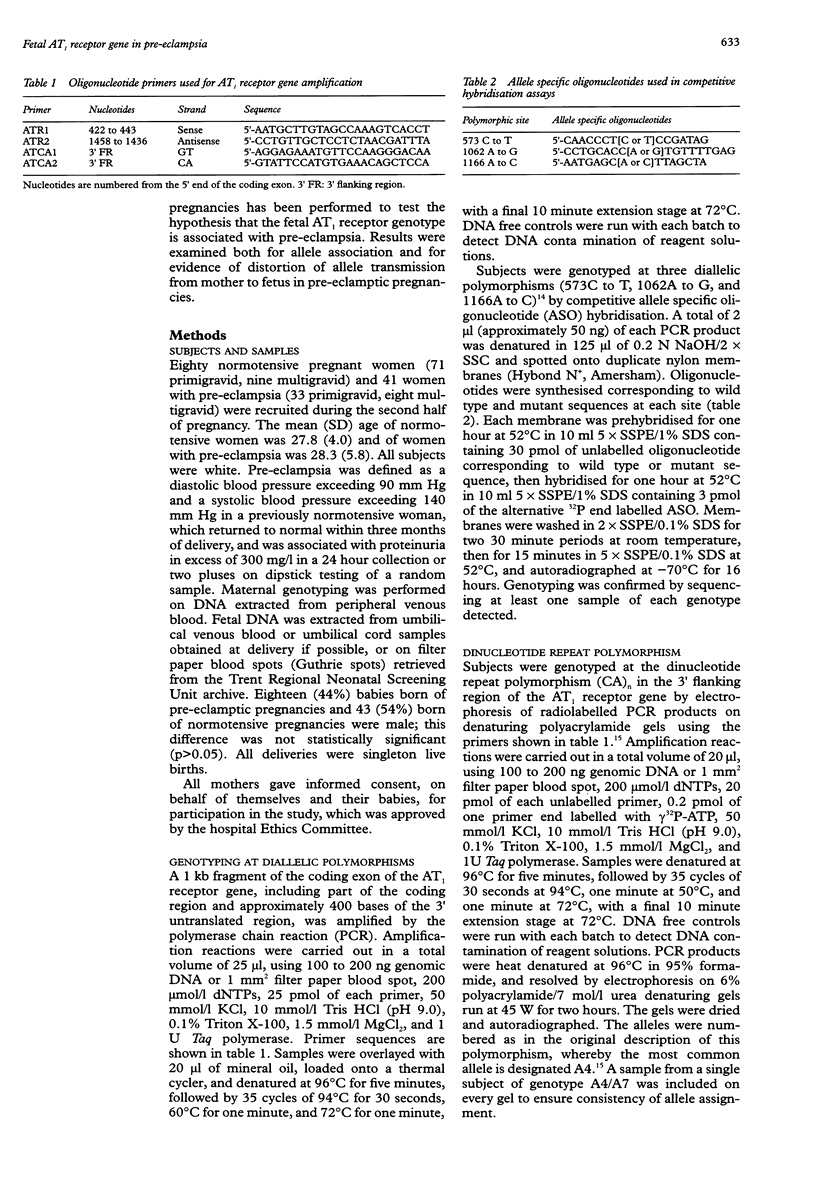
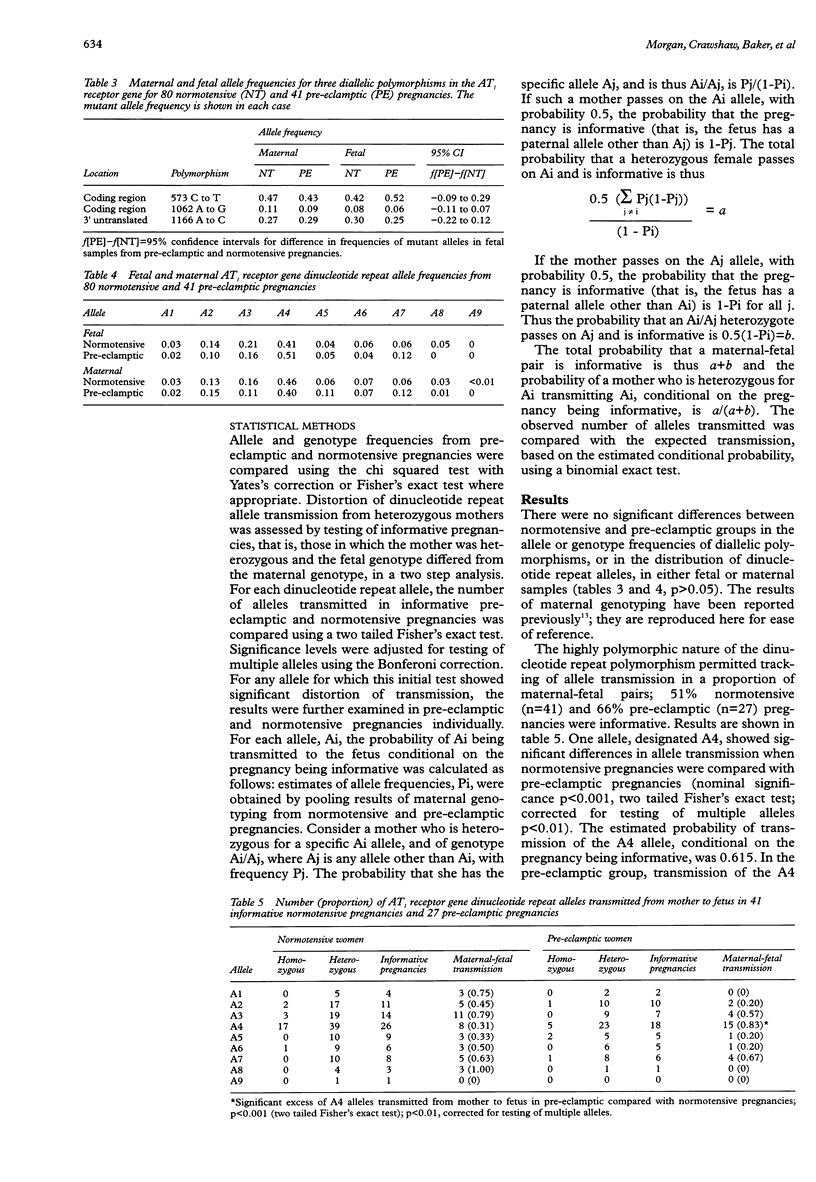
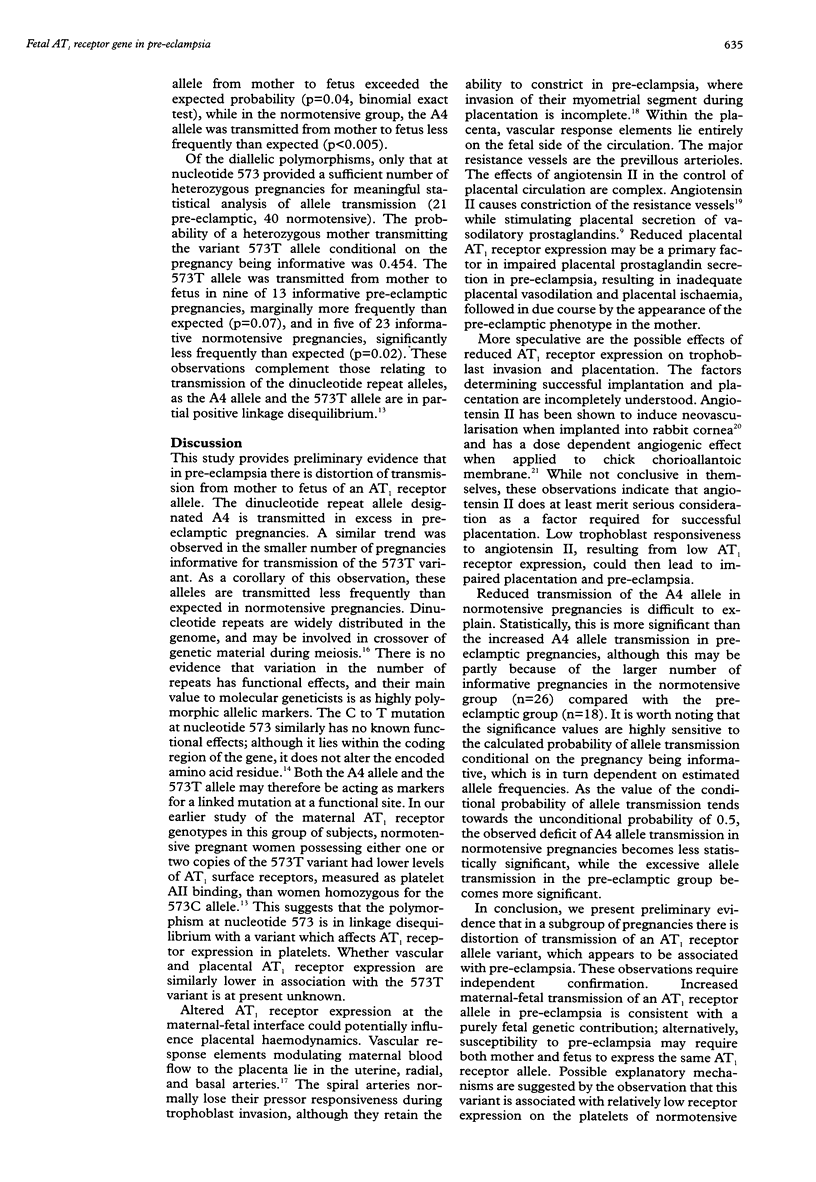
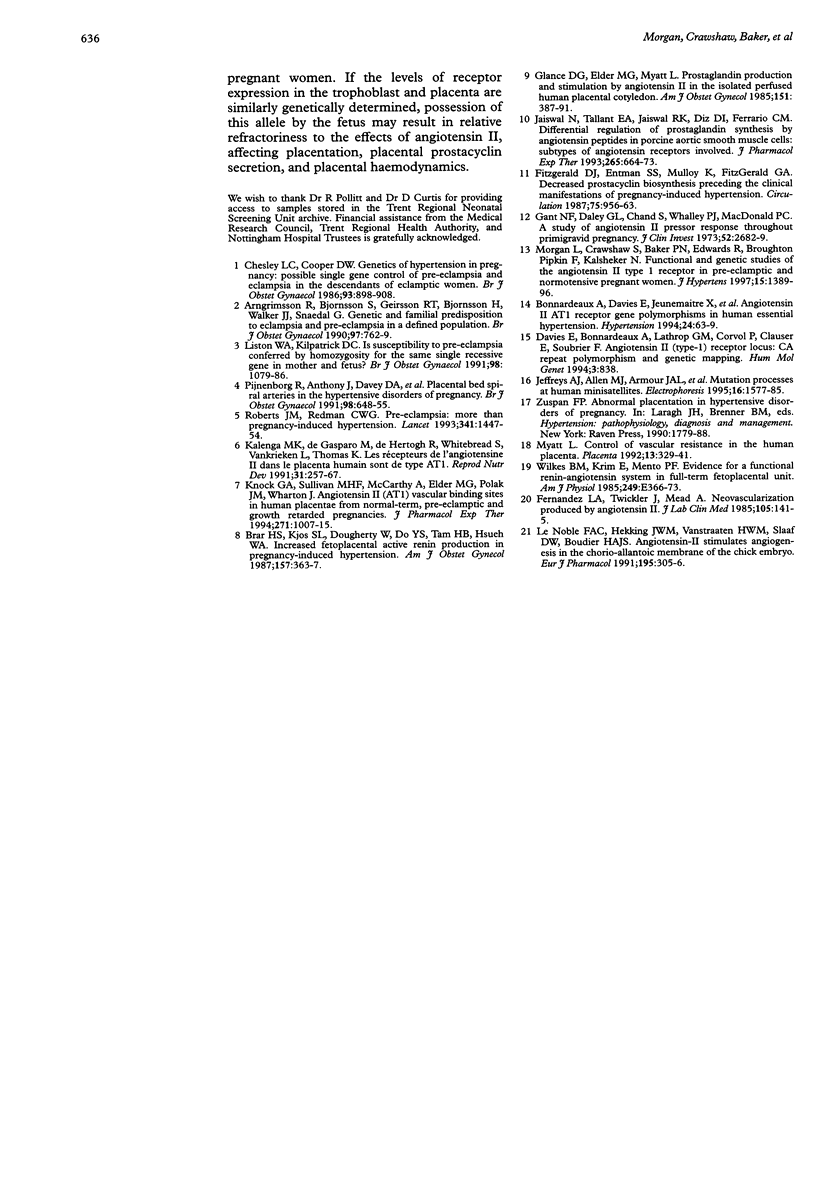
Selected References
These references are in PubMed. This may not be the complete list of references from this article.
- Arngrimsson R., Björnsson S., Geirsson R. T., Björnsson H., Walker J. J., Snaedal G. Genetic and familial predisposition to eclampsia and pre-eclampsia in a defined population. Br J Obstet Gynaecol. 1990 Sep;97(9):762–769. doi: 10.1111/j.1471-0528.1990.tb02569.x. [DOI] [PubMed] [Google Scholar]
- Bonnardeaux A., Davies E., Jeunemaitre X., Féry I., Charru A., Clauser E., Tiret L., Cambien F., Corvol P., Soubrier F. Angiotensin II type 1 receptor gene polymorphisms in human essential hypertension. Hypertension. 1994 Jul;24(1):63–69. doi: 10.1161/01.hyp.24.1.63. [DOI] [PubMed] [Google Scholar]
- Brar H. S., Kjos S. L., Dougherty W., Do Y. S., Tam H. B., Hsueh W. A. Increased fetoplacental active renin production in pregnancy-induced hypertension. Am J Obstet Gynecol. 1987 Aug;157(2):363–367. doi: 10.1016/s0002-9378(87)80173-4. [DOI] [PubMed] [Google Scholar]
- Chesley L. C., Cooper D. W. Genetics of hypertension in pregnancy: possible single gene control of pre-eclampsia and eclampsia in the descendants of eclamptic women. Br J Obstet Gynaecol. 1986 Sep;93(9):898–908. doi: 10.1111/j.1471-0528.1986.tb08006.x. [DOI] [PubMed] [Google Scholar]
- Davies E., Bonnardeaux A., Lathrop G. M., Corvol P., Clauser E., Soubrier F. Angiotensin II (type-1) receptor locus: CA repeat polymorphism and genetic mapping. Hum Mol Genet. 1994 May;3(5):838–838. doi: 10.1093/hmg/3.5.838. [DOI] [PubMed] [Google Scholar]
- Fernandez L. A., Twickler J., Mead A. Neovascularization produced by angiotensin II. J Lab Clin Med. 1985 Feb;105(2):141–145. [PubMed] [Google Scholar]
- Fitzgerald D. J., Entman S. S., Mulloy K., FitzGerald G. A. Decreased prostacyclin biosynthesis preceding the clinical manifestation of pregnancy-induced hypertension. Circulation. 1987 May;75(5):956–963. doi: 10.1161/01.cir.75.5.956. [DOI] [PubMed] [Google Scholar]
- Gant N. F., Daley G. L., Chand S., Whalley P. J., MacDonald P. C. A study of angiotensin II pressor response throughout primigravid pregnancy. J Clin Invest. 1973 Nov;52(11):2682–2689. doi: 10.1172/JCI107462. [DOI] [PMC free article] [PubMed] [Google Scholar]
- Glance D. G., Elder M. G., Myatt L. Prostaglandin production and stimulation by angiotensin II in the isolated perfused human placental cotyledon. Am J Obstet Gynecol. 1985 Feb 1;151(3):387–391. doi: 10.1016/0002-9378(85)90309-6. [DOI] [PubMed] [Google Scholar]
- Jaiswal N., Tallant E. A., Jaiswal R. K., Diz D. I., Ferrario C. M. Differential regulation of prostaglandin synthesis by angiotensin peptides in porcine aortic smooth muscle cells: subtypes of angiotensin receptors involved. J Pharmacol Exp Ther. 1993 May;265(2):664–673. [PubMed] [Google Scholar]
- Jeffreys A. J., Allen M. J., Armour J. A., Collick A., Dubrova Y., Fretwell N., Guram T., Jobling M., May C. A., Neil D. L. Mutation processes at human minisatellites. Electrophoresis. 1995 Sep;16(9):1577–1585. doi: 10.1002/elps.11501601261. [DOI] [PubMed] [Google Scholar]
- Kalenga M. K., de Gasparo M., de Hertogh R., Whitebread S., Vankrieken L., Thomas K. Les récepteurs de l'angiotensine II dans le placenta humain sont de type AT1. Reprod Nutr Dev. 1991;31(3):257–267. [PubMed] [Google Scholar]
- Knock G. A., Sullivan M. H., McCarthy A., Elder M. G., Polak J. M., Wharton J. Angiotensin II (AT1) vascular binding sites in human placentae from normal-term, preeclamptic and growth retarded pregnancies. J Pharmacol Exp Ther. 1994 Nov;271(2):1007–1015. [PubMed] [Google Scholar]
- Le Noble F. A., Hekking J. W., Van Straaten H. W., Slaaf D. W., Struyker Boudier H. A. Angiotensin II stimulates angiogenesis in the chorio-allantoic membrane of the chick embryo. Eur J Pharmacol. 1991 Mar 26;195(2):305–306. doi: 10.1016/0014-2999(91)90552-2. [DOI] [PubMed] [Google Scholar]
- Morgan L., Crawshaw S., Baker P. N., Edwards R., Broughton Pipkin F., Kalsheker N. Functional and genetic studies of the angiotensin II type 1 receptor in pre-eclamptic and normotensive pregnant women. J Hypertens. 1997 Dec;15(12 Pt 1):1389–1396. doi: 10.1097/00004872-199715120-00004. [DOI] [PubMed] [Google Scholar]
- Myatt L. Control of vascular resistance in the human placenta. Placenta. 1992 Jul-Aug;13(4):329–341. doi: 10.1016/0143-4004(92)90057-z. [DOI] [PubMed] [Google Scholar]
- Pijnenborg R., Anthony J., Davey D. A., Rees A., Tiltman A., Vercruysse L., van Assche A. Placental bed spiral arteries in the hypertensive disorders of pregnancy. Br J Obstet Gynaecol. 1991 Jul;98(7):648–655. doi: 10.1111/j.1471-0528.1991.tb13450.x. [DOI] [PubMed] [Google Scholar]
- Roberts J. M., Redman C. W. Pre-eclampsia: more than pregnancy-induced hypertension. Lancet. 1993 Jun 5;341(8858):1447–1451. doi: 10.1016/0140-6736(93)90889-o. [DOI] [PubMed] [Google Scholar]
- Wilkes B. M., Krim E., Mento P. F. Evidence for a functional renin-angiotensin system in full-term fetoplacental unit. Am J Physiol. 1985 Oct;249(4 Pt 1):E366–E373. doi: 10.1152/ajpendo.1985.249.4.E366. [DOI] [PubMed] [Google Scholar]


